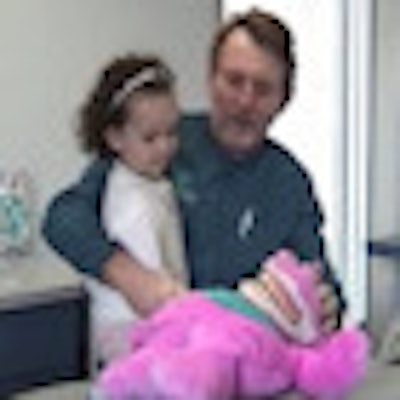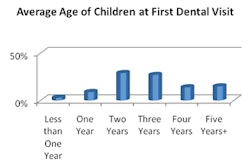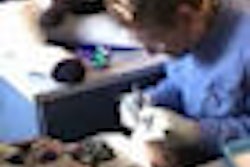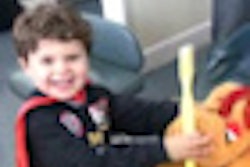
In a series of three articles and videos during February -- Children's Dental Health Month -- DrBicuspid.com is exploring what dental professionals can do to make early childhood visits pleasant and productive for patient and provider alike. The first in the series, When dentists fear children, focused on the distraction technique.
Most kids haven't watched "Marathon Man." They don't come to your office the first time thinking you want to hurt them. Chances are, they don't know what to expect. But that uncertainty is what makes so many so nervous. That's why pediatric dentists have spent decades perfecting the technique of "tell, show, do."
|
|
| The tell, show, do technique for managing children's behavior demonstrated by Issa Sasa, D.D.S., M.S., University of Texas, San Antonio. |
| Having trouble viewing this clip? Click here to download the free Flash player. |
"Tell, show, do is so effective in behavior management because it eliminates the fear of the unknown," said Issa Sasa, D.D.S., M.S., who teaches behavior management to dental students at the University of Texas, San Antonio. "It's the cornerstone of child education."
The technique not only defuses anxieties, it reinforces the behavior the dental practitioner is trying to convey to the child by repeating the same message through aural, visual, and tactile communication.
Some practitioners begin even before the first appointment by supplying parents with information to relay to the children. They may recommend children's books about dental visits. They may also ask parents about the children's tastes and interests. By the time the kids arrive, the staff knows to talk about a child's favorite super hero or have stickers of a particular cartoon character ready.
First impressions
The first meeting is important, too, said Leticia Mendoza-Sobel, D.D.S., who teaches behavior management at the University of the Pacific Arthur A. Dugoni School of Dentistry. The practitioner must begin building a rapport within the first few seconds.
"What I do is say, 'Hi,' and then I smile and introduce myself," she said. "I kneel down so I can be at the same eye level, and I ask questions. Usually, they are very silly questions: 'Do you know what are we doing for you today?' 'Are we cutting your hair?' 'Are we checking your ears?' "
In the "tell" phase of the technique, Dr. Sasa chooses euphemisms that are appropriate for the patient and uses them to explain a procedure just before he does it. "I sometimes term that 'childrenese,' " he said.
Some common euphemisms:
|
|
| Ben Taylor, D.D.S., demonstrates the tell, show, do technique using a stuffed animal. Video courtesy of Dr. Taylor, Pediatric Dentistry of San Antonio. |
| Having trouble viewing this clip? Click here to download the free Flash player. |
| Caries | sugar bugs |
| Evacuator | vacuum |
| Explorer | tooth counter |
| High-speed handpiece | Mr. Whistle |
| Fluoride | tooth vitamins |
| Light | Mr. Sunshine |
| Local anesthetic | sleepy juice |
| Mouth prop | tooth pillow |
| Radiograph | picture |
| Rubber dam | raincoat |
| Rubber dam clamp | tooth ring |
| Low-speed handpiece | Mr. Bumpy |
So you might say, "First, I'm going to use this tooth pillow so your tooth can rest. Then I'm going to put a raincoat on your tooth with this tooth ring."
"Some practitioners forget how important it is to really be mindful of telling a child every single step that you do, from turning on the light to moving the chair," Dr. Sasa said.
Once you've explained the procedure, you can demonstrate many of the techniques on the child's hand. For example, you can let the child feel the motion of a prophy angle on a fingernail. You can also demonstrate on a model, such as a stuffed animal, or even a parent.
Praise and communication
The tell, show, do technique combines well with other techniques such as distraction. Dr. Sasa tells his patients that during an injection they will feel "a pinch like a mosquito bite." During the actual injection, he mentions that they are now feeling the pinch he told them to expect. Then he distracts them by asking them to count along with him.
At the moment of the injection, Dr. Mendoza-Sobel said she often distracts her patients with animal noises.
Along with tell, show, do comes "praise and communication," Dr. Sasa said. He makes a point of complimenting his patients when he first sees them: "I like your shoes." "What a great T-shirt. Where can I get one?"
And he praises them abundantly when they have cooperated during a procedure. "Try to penetrate that shell," he said.
Using such techniques, Dr. Mendoza-Sobel and Dr. Sasa are able to manage almost all their young patients. But both stress that there are exceptions. Many children will cooperate better when nitrous oxide is used, and some will require physical restraint or general anesthesia. Practitioners should not feel they have failed when that happens.
"I think a lot of clinicians are really hard on themselves when a technique doesn't work," Dr. Sasa said. "And that's why I emphasize this continuum. If one technique doesn't work, we can always move on to another."
Next week: Not every child can understand what you are telling or showing them. Babies and many toddlers and young children with cognitive disorders may best be treated using the lap-to-lap technique, as we explain in the the third article in this series.
Copyright © 2010 DrBicuspid.com



















